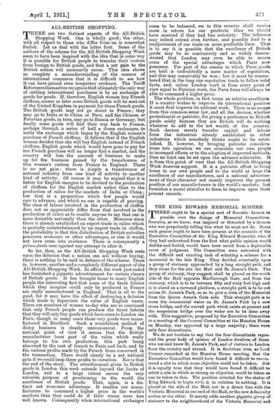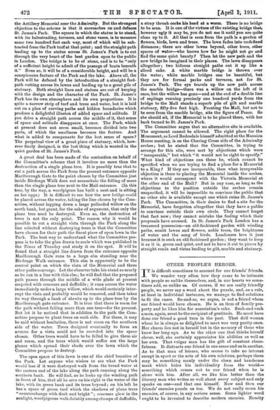THE KING EDWARD MEMORIAL SCHEME.
THERE ought to be a special sort of Socratic daimon to preside over the doings of Memorial Committees. Socrates, as we know, was inspired or thwarted by a daemon who was perpetually telling him what he must not do. Some such genius ought to have been present at the councils of the Executive Committee of the King Edward Memorial, who, if they had understood from the first what public opinion would dislike and forbid, would have been saved from a deplorable error of judgment. The Committee were entrusted with the difficult and exacting task of selecting a scheme for a memorial to the late King. They decided, eventually, upon a group of statuary approached by a long straight path, and they chose for the site the Mall and St. James's Park. The group of statuary, they suggest, shall be placed on the south side of the Mall opposite Marlborough Gate, and from the statuary, which is to be between fifty and sixty feet high and is to stand on a terraced platform, a straight path is to be out across St. James's Park, so as to give a vista of the Memorial from the Queen Anne's Gate side. This straight path is to cross the ornamental water on St. James's Park by a new stone bridge, and the curved path which exists at present and the suspension bridge over the water are to be done away with. This suggestion, proposed by the Executive Committee to a meeting of the General Committee at the Mansion House on Monday, was approved by a large majority; there were only four dissentients.
We do not hesitate to say that the four dissentients repre- sent the great body of opinion of London dwellers, of those who use and know St. James's Park, and of visitors to London from the country and abroad. It is doubtless true, as Lord Cromer remarked at the Mansion House meeting, that the Executive Committee would have found it difficult to recom- mend a site to which some objection could not be taken. But it is equally true that they would have found it difficult to select a site to which so strong an objection could be taken as can be taken to this. The position selected for the statue of King Edward, to begin with, is in relation to nothing. It is placed at the side of the Mall, not in a direct line with the Victoria Memorial at one end of the Mall, or the new Admiralty arches at the other. It merely adds another gigantic group of statuary to the neighbourhood of the Victoria Memorial and the Artillery Memorial near the Admiralty. But the strongest objection to the scheme is that it encroaches on and defaces St. James's Park. The square in which the statue is to stand, with its balnstrading, terraces, and stone vases, is to measure some two hundred feet each way, most of which will be sub- tracted from the Park turf at that point ; and the straight path leading up to the statue across St. James's Park is to out through the very heart of the best garden open to the public in London. The bridge is to be of stone, and is to be "only of a sufficient height to admit of the passage of boats beneath it." Even so, it will be of a considerable height, and will be a conspicuous feature of the Park and the lake. Above all, the Park will be defaced by the introduction of a straight foot- path cutting across its lawns and leading up to a great pile of statuary. Both straight lines and statues are out of keeping with the design and the character of the Park. St. James's Park has its own atmosphere and its own proportions. It is quite a narrow strip of turf and trees and water, but it is laid out on a plan of curving paths and hidden boundaries which produce a delightful illusion of added space and solitude. If you drive a straight path across the middle of it, that sense of space and solitude disappears at once. The Park, which at present does not seem small, becomes divided into two parts, of which the smallness becomes the feature. And what is added to compensate for the lost sense of space P The perpetual view of a great piece of statuary, which, how- ever finely designed, is the last thing which is wanted in the quiet garden of St. James's Park.
A great deal has been made of the contention on behalf of the Committee's scheme that it involves no more than the destruction of a single plane tree. It is possibly true that to cut a path across the Park from the present entrance opposite Marlborough Gate to the point chosen by the Committee just inside Birdcage Walk does not necessitate the felling of more than the single plane tree next to the Mall entrance. (In this tree, by the way, a woodpigeon has Wit a nest and is sitting on her eggs.) It is difficult to see how the new bridge could be placed across the water, taking the line chosen by the Com- mittee, without lopping down a large pollarded willow on the north bank, but grant, for the sake of argument, that only the plane tree need be destroyed. Even so, the destruction of trees is not the only point. The reason why it would be possible to cut a straight vista through the Park along the line selected without destroying trees is that the Committee have chosen for their path the finest piece of open lawn in the Park. The best way to understand what the Committee pro- pose is to take the plan drawn to scale which was published in the Times of Tuesday and study it on the spot. It will be found that a straight line drawn from the entrance opposite Marlborough Gate runs to a large elm standing near the Birdcage Walk entrance. This elm is apparently to be the central point on which the vista of the Memorial and three other paths converge. Let the observer take his stand as nearly as he can in a line with this elm ; he will find that the proposed path passes through the middle of a wide glade at present carpeted with crocuses and daffodils ; it rims across the water immediately under a large willow, which would certainly inter- rupt the vista and probably would be removed, and then takes its way through a bank of shrubs up to the plane tree by the Marlborough gate entrance. It is true that there is room for the path without felling more than one tree—for the present. But let it be noticed that in addition to the path the Cora. mittee propose to plant trees on each side. For these, it may be said without hesitation, there is not room on the southern side of the water. Trees designed eventually to form an avenue for a vista could not be crowded into the space chosen. Other trees would have to be felled to give them air and room, and the trees which would suffer are the large planes which spread their shade over the lawn which the Committee propose to destroy.
The open space of this lawn is one of the chief beauties of the Park. Let anyone who wishes to see what the Park would lose if it were destroyed walk from the broad water at the eastern end of the lake along the path running along the southern bank. He will find, as he looks up the winding path in front of him, that all he sees on his right is the water of the lake, with its green bank and its trees beyond ; on his left he has a space of green turf which the shadows of plane trees " counterchange with dusk and bright " ; crocuses glow in the sunlight, woodpigeons walk daintily among clumps of daffodils,
a stray thrush cocks his head at a worm. There is no bridge to be seen. It is one of the virtues of the existing bridge that, however ugly it may be, you do not see it until you are quite close up to it. All that is seen from the path is a garden of flowers, birds, lawn and trees. The lawn fades into undefined distances ; there are other lawns beyond, other trees, other spaces of water—who knows how far he might not go and find the same quiet beauty P Then let the new path and the new bridge be imagined in their places. The lawn disappears altogether; two hideous straight paths cut it up like a sliced cake. A white marble bridge is thrown over the water; white marble bridges can be beautiful, but they are for formal parks and terraces, not for St. James's Park. The eye travels up the new path across the marble bridge—there was a willow on the left of it once, but the willow has gone—and at the end of a double line of saplings running precisely one hundred yards from the bridge to the Mall stands a superb pile of gilt and marble statuary, fifty-five feet high. Fronting the Mall, but not to be seen from the marble bridge, site the figure of Peace. So she should sit, if the Memorial is to be placed there, with her back turned to St. James's Park.
The Committee argue that no alternative site is available. The argument cannot be allowed. The right place for the Monument, as Lord Redesdale himself admitted at the Mansion House meeting, is on the Charing Cross side of the .Admiralty arches ; but he stated that the Committee, in trying to arrange for this site, were met by objections which were " insuperable," but which "it would not be right to specify." What kind of objections can these be, which cannot be specified when we are trying to find, a place for a Memorial to a King P If they are insuperable, then what insuperable objection is there to placing the Memorial inside the arches, where it would correspond with the Victoria Memorial at the other end of the Mall P But in any case, so long as the objections to the position outside the arches remain unspecified, it will be impossible to convince the public that no other site is available except one which ruins St. James's Park. The Committee, in their desire to find a site for the Memorial, have forgotten altogether that they have a public to convince outside their own circle. They cannot forget that fact now; they cannot mistake the feeling which their proposals have aroused. In St. James's Park London has a treasured possession—an old-fashioned garden with winding paths, sunlit lawns and flowers, noble trees, the brightness of water and the song of birds. Londoners love it just because it is such an old-fashioned garden ; they want to keep it as it is, green and quiet, and not to have it cut to pieces by straight roads and vistas leading to gilt, marble and statuary,











































 Previous page
Previous page